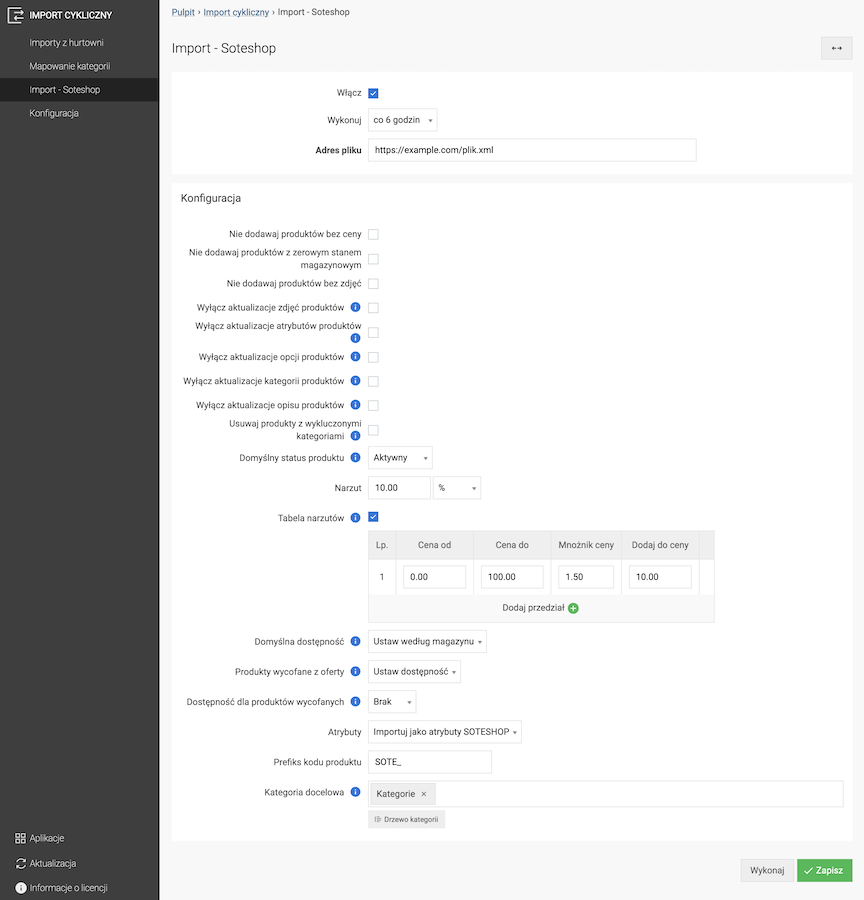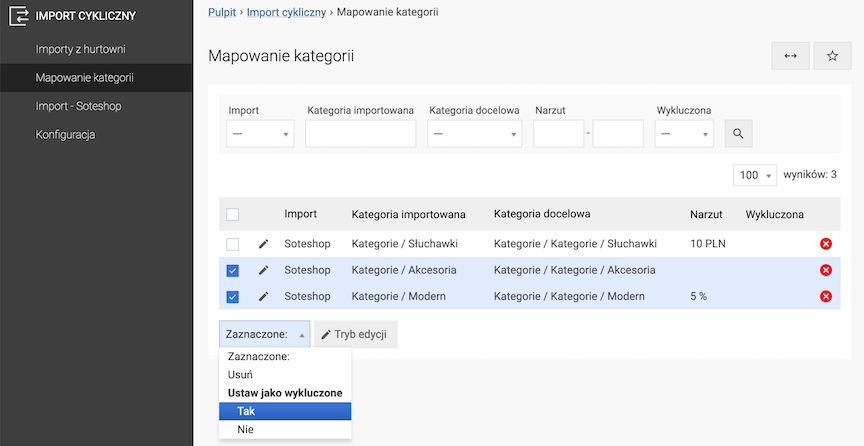Periodic Import - Integration with Warehouses
Integration of the store with the warehouse. The cyclic import allows for the cyclic import of product data from internet warehouse to the online store. Import of new products, updates, category mapping, margins, individual configuration. Check out the ready integrations: Warehouses and dropshipping.
Table of Contents
- List of imports
- Configuration of import from warehouse
- Category mapping
- Import logs
- Configuration
- Integrations with warehouses - practical advice
Example import of data from a warehouse based on another SOTESHOP store.
In the administrative panel, select Offer → Cyclic import
List of imports

- Click the
icon to go to import editing.
- Click the
icon to execute the import from the warehouse manually.
Warehouse import configuration
Go to the edit of the selected import.

- Check Enable,
- Select the import execution frequency in the Execute field,
- Enter the File address,
Address to the file with products, received from the warehouse.
- Check Do not add products without price,
- Check Do not add products with zero stock,
- Check Do not add products without pictures,
- Check Disable product picture updates,
If checked, disables product picture updates on re-importing data.
- Check Disable product attribute updates,
If checked, disables product attribute updates on re-importing data.
- Check Disable product option updates,
If checked, disables product option updates on re-importing data.
- Check Disable product category updates,
If checked, disables product category updates on re-importing data.
- Check Disable product description updates,
If checked, it disables product description updates when data is reimported.
- Check Remove products with excluded categories,
Checking this option will cause previously added products to be physically removed from the store's offer if their category is marked as excluded. By default, previously imported products are not removed from the store's offer despite their category being excluded.
- Select Default product status,
Specifies the default status of newly imported products. If the option is set to Inactive, the Products withdrawn from the offer option will not automatically set the product to active if it is available in the offer.
- Enter Margin,
This margin will be applied to all products from the import. The margin can be monetary or percentage.
- Select Default availability,
Specifies the default availability to be set for newly imported products.
- Choose what to do in the case of Products withdrawn from the offer,
Specifies what action to take for products withdrawn from the wholesaler's offer. For automatic resumption of products for deactivated values, the Default product status option must be set to Active.
- Choose how to import Attributes,
- Enter Product code prefix,
- Select Target category.
If the imported product has a nesting category Accessories/Keychains and the target category points to the store category Categories/New products then the product category after import is Categories/New products/Accessories/Keychains. If the target category is not completed, new products are imported into the hidden category tree with the same name as the import name.
- Click the Save button.
Category mapping
Go to Category Mapping

Categories on the list will appear after the first import.
- Check the categories,
- Select Selected: Set as excluded to Yes or No,
- Go to the edit mapping of a given category by clicking the icon
,

- Check Exclude,
If checked, the imported category and all its products are skipped during import.
- Select Target category,
- Check Margin if you want to add a margin to the products of a given category and enter the margin value. The margin can be a fixed amount or a percentage.
- Press the Save button.
- Check Exclude,
Wholesaler import logs
To view the import logs, go to Applications → Task Scheduler and search for the task corresponding to the cyclic import from a given wholesaler. See the Task Scheduler documentation.
Configuration
Go to Configuration

- Select Enable,
- Click the Save button.
Integrations with wholesalers - practical tips
Depending on the supplier from whom the products will be downloaded, we will have different options available in the import. Most of them, however, are common, thus allowing us to customize the imported products to our needs.
File address
Before we start the first import, we must provide the link to the XML or CSV file (depending on the import) in the import configuration.
- The correctness of such a link can be verified by opening it in the browser.
- If the link is correct, we should see the XML file structure or download the file in the case of a CSV file.
- Some imports have more than one place for a link, e.g. a separate warehouse file or photos.
Quantity and time of imports
Imports are designed for cyclic, automatic downloading of products from the supplier, so you can set how often the data should be downloaded again - we suggest every 6 - 12 hours. An important issue is the time it takes to perform a given import. In the case of a very large number of products, the first import may take even several hours, this is due to the need to download a very large amount of data (photos). This is also dependent on the computing power of both the supplier's and recipient's server. Subsequent imports should be much faster, as there is no need to download photos again. Nevertheless, it is always an operation that burdens the server on which the store is installed.
First import
On the first import, all products from the supplier's file are downloaded. It should be taken into account whether the store has space to download all products. In case of lack of space for additional products up to 10,000 - 30,000 (depending on the version), the import will not add any more products.
In order to optimize the number of imported products, it is possible to check in the configuration to skip products that do not have photos and their stock level is zero.
Prefix of product code
An important element is the prefix of the products from the given import. It allows easy distinction of products from the given import. To search for all products from the given import, just enter the prefix in the place of the code on the list of products.
Categories
Products are imported to a separate (hidden) category, whose name comes from the name of the import. After the first import, the mapping of categories from the given import will be done. After mapping the categories of the given import, it will be possible to exclude the entire category from the import and assign independent price markups for the given category. In case of excluding a given category, during the next import, products from this category will not be imported.